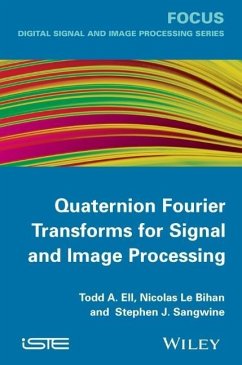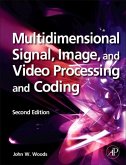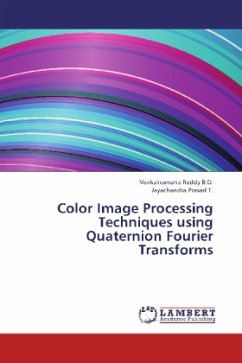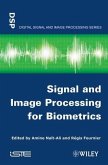Todd A. Ell, Nicolas Le Bihan, Stephen J. Sangwine
Quaternion Fourier Transforms for Signal and Image Processing
Todd A. Ell, Nicolas Le Bihan, Stephen J. Sangwine
Quaternion Fourier Transforms for Signal and Image Processing
- Gebundenes Buch
- Merkliste
- Auf die Merkliste
- Bewerten Bewerten
- Teilen
- Produkt teilen
- Produkterinnerung
- Produkterinnerung
Based on updates to signal and image processing technology made inthe last two decades, this text examines the most recent researchresults pertaining to Quaternion Fourier Transforms. QFT is acentral component of processing color images and complex valuedsignals. The book's attention to mathematical concepts,imaging applications, and Matlab compatibility render it anirreplaceable resource for students, scientists, researchers, andengineers.
Andere Kunden interessierten sich auch für
![Multidimensional Signal, Image, and Video Processing and Coding Multidimensional Signal, Image, and Video Processing and Coding]() John W. WoodsMultidimensional Signal, Image, and Video Processing and Coding68,99 €
John W. WoodsMultidimensional Signal, Image, and Video Processing and Coding68,99 €![Color Image Processing Techniques using Quaternion Fourier Transforms Color Image Processing Techniques using Quaternion Fourier Transforms]() Venkatramana Reddy B.D.Color Image Processing Techniques using Quaternion Fourier Transforms38,99 €
Venkatramana Reddy B.D.Color Image Processing Techniques using Quaternion Fourier Transforms38,99 €![Regularization and Bayesian Methods for Inverse Problems in Signal and Image Processing Regularization and Bayesian Methods for Inverse Problems in Signal and Image Processing]() Regularization and Bayesian Methods for Inverse Problems in Signal and Image Processing164,99 €
Regularization and Bayesian Methods for Inverse Problems in Signal and Image Processing164,99 €![Digital Design of Signal Processing Systems Digital Design of Signal Processing Systems]() Shoab A. KhanDigital Design of Signal Processing Systems146,99 €
Shoab A. KhanDigital Design of Signal Processing Systems146,99 €![Generalizations of Cyclostationary Signal Processing Generalizations of Cyclostationary Signal Processing]() Antonio NapolitanoGeneralizations of Cyclostationary Signal Processing154,99 €
Antonio NapolitanoGeneralizations of Cyclostationary Signal Processing154,99 €![Signal and Image Processing for Biometrics Signal and Image Processing for Biometrics]() Signal and Image Processing for Biometrics164,99 €
Signal and Image Processing for Biometrics164,99 €![Streamlining Digital Signal Processing Streamlining Digital Signal Processing]() Streamlining Digital Signal Processing90,99 €
Streamlining Digital Signal Processing90,99 €-
-
-
Based on updates to signal and image processing technology made inthe last two decades, this text examines the most recent researchresults pertaining to Quaternion Fourier Transforms. QFT is acentral component of processing color images and complex valuedsignals. The book's attention to mathematical concepts,imaging applications, and Matlab compatibility render it anirreplaceable resource for students, scientists, researchers, andengineers.
Produktdetails
- Produktdetails
- ISTE Focus
- Verlag: Wiley & Sons
- 1. Auflage
- Seitenzahl: 160
- Erscheinungstermin: 23. Juni 2014
- Englisch
- Abmessung: 236mm x 160mm x 20mm
- Gewicht: 674g
- ISBN-13: 9781848214781
- ISBN-10: 1848214782
- Artikelnr.: 40046540
- Herstellerkennzeichnung
- Libri GmbH
- Europaallee 1
- 36244 Bad Hersfeld
- gpsr@libri.de
- ISTE Focus
- Verlag: Wiley & Sons
- 1. Auflage
- Seitenzahl: 160
- Erscheinungstermin: 23. Juni 2014
- Englisch
- Abmessung: 236mm x 160mm x 20mm
- Gewicht: 674g
- ISBN-13: 9781848214781
- ISBN-10: 1848214782
- Artikelnr.: 40046540
- Herstellerkennzeichnung
- Libri GmbH
- Europaallee 1
- 36244 Bad Hersfeld
- gpsr@libri.de
Todd A. Ell, Engineering Fellow, Goodrich Sensors and Integrated Systems, Burnsville, MN, USA. Nicolas Le Bihan, Researcher, CNRS, Grenoble, France. Stephen J. Sangwine, Senior Lecturer, University of Essex, United Kingdom.
Nomenclature ix Preface xi Introduction xiii Chapter 1. Quaternion algebra 1 1.1. Definitions 1 1.2. Properties 2 1.3. Exponential and logarithm of a quaternion 7 1.3.1. Exponential of a pure quaternion 7 1.3.2. Exponential of a full quaternion 9 1.3.3. Logarithm of a quaternion 10 1.4. Representations 11 1.4.1. Polar forms 11 1.4.2. The
j -pair notation 15 1.4.3.
and
matrix representations 17 1.5. Powers of a quaternion 18 1.6. Subfields 18 Chapter 2. Geometric applications 21 2.1. Euclidean geometry (3D and 4D) 21 2.1.1. 3D reflections 22 2.1.2. 3D rotations 22 2.1.3. 3D shears 24 2.1.4. 3D dilations 24 2.1.5. 4D reflections 25 2.1.6. 4D rotations 25 2.2. Spherical geometry 26 2.3. Projective space (3D) 28 2.3.1. Systems of linear quaternion functions 31 2.3.2. Projective transformations 33 Chapter 3. Quaternion fourier transforms 35 3.1. 1D quaternion Fourier transforms 38 3.1.1. Definitions 38 3.1.2. Basic transform pairs 40 3.1.3. Decompositions 42 3.1.4. Inter-relationships between definitions 45 3.1.5. Convolution and correlation theorems 47 3.2. 2D quaternion Fourier transforms 48 3.2.1. Definitions 48 3.2.2. Basic transform pairs 52 3.2.3. Decompositions 54 3.2.4. Inter-relationships between definitions 55 3.3. Computational aspects 57 3.3.1. Coding 57 3.3.2. Verification 62 3.3.3. Verification of transforms 62 Chapter 4. Signal and image processing 67 4.1. Generalized convolution 67 4.1.1. Classical grayscale image convolution filters 67 4.1.2. Color images as quaternion arrays 70 4.1.3. Quaternion convolution 70 4.1.4. Quaternion image spectrum 73 4.2. Generalized correlation 79 4.2.1. Classical correlation and phase correlation 81 4.2.2. Quaternion correlation 86 4.2.3. Quaternion phase correlation 88 4.3. Instantaneous phase and amplitude of complex signals 91 4.3.1. Important properties of 1D QFT of a complex signal z(t) 91 4.3.2. Hilbert transform and right-sided quaternion spectrum 96 4.3.3. The quaternion signal associated with a complex signal 98 4.3.4. Instantaneous amplitude and phase 101 4.3.5. The instantaneous frequency of a complex signal 102 4.3.6. Examples 104 4.3.7. The quaternion Wigner-Ville distribution of a complex signal 109 4.3.8. Time marginal 113 4.3.9. The mean frequency formula 113 Bibliography 117 Index 123
j -pair notation 15 1.4.3.
and
matrix representations 17 1.5. Powers of a quaternion 18 1.6. Subfields 18 Chapter 2. Geometric applications 21 2.1. Euclidean geometry (3D and 4D) 21 2.1.1. 3D reflections 22 2.1.2. 3D rotations 22 2.1.3. 3D shears 24 2.1.4. 3D dilations 24 2.1.5. 4D reflections 25 2.1.6. 4D rotations 25 2.2. Spherical geometry 26 2.3. Projective space (3D) 28 2.3.1. Systems of linear quaternion functions 31 2.3.2. Projective transformations 33 Chapter 3. Quaternion fourier transforms 35 3.1. 1D quaternion Fourier transforms 38 3.1.1. Definitions 38 3.1.2. Basic transform pairs 40 3.1.3. Decompositions 42 3.1.4. Inter-relationships between definitions 45 3.1.5. Convolution and correlation theorems 47 3.2. 2D quaternion Fourier transforms 48 3.2.1. Definitions 48 3.2.2. Basic transform pairs 52 3.2.3. Decompositions 54 3.2.4. Inter-relationships between definitions 55 3.3. Computational aspects 57 3.3.1. Coding 57 3.3.2. Verification 62 3.3.3. Verification of transforms 62 Chapter 4. Signal and image processing 67 4.1. Generalized convolution 67 4.1.1. Classical grayscale image convolution filters 67 4.1.2. Color images as quaternion arrays 70 4.1.3. Quaternion convolution 70 4.1.4. Quaternion image spectrum 73 4.2. Generalized correlation 79 4.2.1. Classical correlation and phase correlation 81 4.2.2. Quaternion correlation 86 4.2.3. Quaternion phase correlation 88 4.3. Instantaneous phase and amplitude of complex signals 91 4.3.1. Important properties of 1D QFT of a complex signal z(t) 91 4.3.2. Hilbert transform and right-sided quaternion spectrum 96 4.3.3. The quaternion signal associated with a complex signal 98 4.3.4. Instantaneous amplitude and phase 101 4.3.5. The instantaneous frequency of a complex signal 102 4.3.6. Examples 104 4.3.7. The quaternion Wigner-Ville distribution of a complex signal 109 4.3.8. Time marginal 113 4.3.9. The mean frequency formula 113 Bibliography 117 Index 123
Nomenclature ix Preface xi Introduction xiii Chapter 1. Quaternion algebra 1 1.1. Definitions 1 1.2. Properties 2 1.3. Exponential and logarithm of a quaternion 7 1.3.1. Exponential of a pure quaternion 7 1.3.2. Exponential of a full quaternion 9 1.3.3. Logarithm of a quaternion 10 1.4. Representations 11 1.4.1. Polar forms 11 1.4.2. The
j -pair notation 15 1.4.3.
and
matrix representations 17 1.5. Powers of a quaternion 18 1.6. Subfields 18 Chapter 2. Geometric applications 21 2.1. Euclidean geometry (3D and 4D) 21 2.1.1. 3D reflections 22 2.1.2. 3D rotations 22 2.1.3. 3D shears 24 2.1.4. 3D dilations 24 2.1.5. 4D reflections 25 2.1.6. 4D rotations 25 2.2. Spherical geometry 26 2.3. Projective space (3D) 28 2.3.1. Systems of linear quaternion functions 31 2.3.2. Projective transformations 33 Chapter 3. Quaternion fourier transforms 35 3.1. 1D quaternion Fourier transforms 38 3.1.1. Definitions 38 3.1.2. Basic transform pairs 40 3.1.3. Decompositions 42 3.1.4. Inter-relationships between definitions 45 3.1.5. Convolution and correlation theorems 47 3.2. 2D quaternion Fourier transforms 48 3.2.1. Definitions 48 3.2.2. Basic transform pairs 52 3.2.3. Decompositions 54 3.2.4. Inter-relationships between definitions 55 3.3. Computational aspects 57 3.3.1. Coding 57 3.3.2. Verification 62 3.3.3. Verification of transforms 62 Chapter 4. Signal and image processing 67 4.1. Generalized convolution 67 4.1.1. Classical grayscale image convolution filters 67 4.1.2. Color images as quaternion arrays 70 4.1.3. Quaternion convolution 70 4.1.4. Quaternion image spectrum 73 4.2. Generalized correlation 79 4.2.1. Classical correlation and phase correlation 81 4.2.2. Quaternion correlation 86 4.2.3. Quaternion phase correlation 88 4.3. Instantaneous phase and amplitude of complex signals 91 4.3.1. Important properties of 1D QFT of a complex signal z(t) 91 4.3.2. Hilbert transform and right-sided quaternion spectrum 96 4.3.3. The quaternion signal associated with a complex signal 98 4.3.4. Instantaneous amplitude and phase 101 4.3.5. The instantaneous frequency of a complex signal 102 4.3.6. Examples 104 4.3.7. The quaternion Wigner-Ville distribution of a complex signal 109 4.3.8. Time marginal 113 4.3.9. The mean frequency formula 113 Bibliography 117 Index 123
j -pair notation 15 1.4.3.
and
matrix representations 17 1.5. Powers of a quaternion 18 1.6. Subfields 18 Chapter 2. Geometric applications 21 2.1. Euclidean geometry (3D and 4D) 21 2.1.1. 3D reflections 22 2.1.2. 3D rotations 22 2.1.3. 3D shears 24 2.1.4. 3D dilations 24 2.1.5. 4D reflections 25 2.1.6. 4D rotations 25 2.2. Spherical geometry 26 2.3. Projective space (3D) 28 2.3.1. Systems of linear quaternion functions 31 2.3.2. Projective transformations 33 Chapter 3. Quaternion fourier transforms 35 3.1. 1D quaternion Fourier transforms 38 3.1.1. Definitions 38 3.1.2. Basic transform pairs 40 3.1.3. Decompositions 42 3.1.4. Inter-relationships between definitions 45 3.1.5. Convolution and correlation theorems 47 3.2. 2D quaternion Fourier transforms 48 3.2.1. Definitions 48 3.2.2. Basic transform pairs 52 3.2.3. Decompositions 54 3.2.4. Inter-relationships between definitions 55 3.3. Computational aspects 57 3.3.1. Coding 57 3.3.2. Verification 62 3.3.3. Verification of transforms 62 Chapter 4. Signal and image processing 67 4.1. Generalized convolution 67 4.1.1. Classical grayscale image convolution filters 67 4.1.2. Color images as quaternion arrays 70 4.1.3. Quaternion convolution 70 4.1.4. Quaternion image spectrum 73 4.2. Generalized correlation 79 4.2.1. Classical correlation and phase correlation 81 4.2.2. Quaternion correlation 86 4.2.3. Quaternion phase correlation 88 4.3. Instantaneous phase and amplitude of complex signals 91 4.3.1. Important properties of 1D QFT of a complex signal z(t) 91 4.3.2. Hilbert transform and right-sided quaternion spectrum 96 4.3.3. The quaternion signal associated with a complex signal 98 4.3.4. Instantaneous amplitude and phase 101 4.3.5. The instantaneous frequency of a complex signal 102 4.3.6. Examples 104 4.3.7. The quaternion Wigner-Ville distribution of a complex signal 109 4.3.8. Time marginal 113 4.3.9. The mean frequency formula 113 Bibliography 117 Index 123








